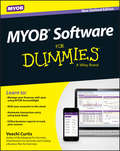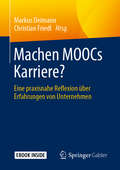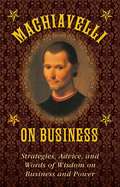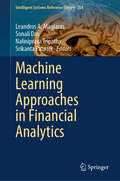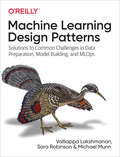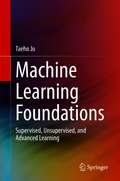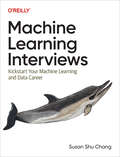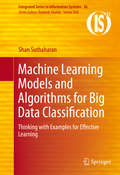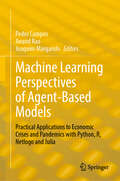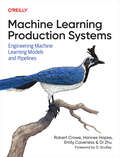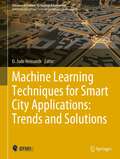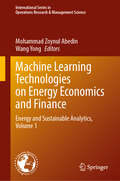- Table View
- List View
MYOB Software For Dummies - NZ
by Veechi CurtisManage your business accounts more effectively with MYOB AccountRight Understanding the ins and outs of your business accounting system is vital to continued business success. From setting up your accounting file to analysing sales figures - and everything in between - MYOB Software For Dummies covers everything you need to know about using MYOB AccountRight in New Zealand. With in-depth coverage of all the features in MYOB AccountRight, plus extensive guidance on utilising MYOB AccountRight's cloud-based accounting features, this fun and accessible guide will help you become an MYOB master! For the first time, For Dummies offers a handbook for using MYOB software that's tailored for New Zealand-based customers. No matter which version of the AccountRight software you're working with, this friendly guide provides easy-to-follow, New Zealand-specific information on using it to maximise your MYOB knowledge. You'll quickly get up and running on New Zealand GST and local payroll options, as well as monitoring sales and purchases, preparing Business Activity Statements, reporting for success, upgrading your software, and so much more. Manage your day-to-day business Analyse trends in business activity Explores the opportunities of working in the cloud and sharing data Use business reporting features to track your success Flags information specific to the latest MYOB AccountRight upgrades so you can quickly update your knowledge Saves you hours of time (every week!) with helpful hints and shortcuts If you're new to MYOB - or new to the latest version - this New Zealand edition of MYOB Software For Dummies will be the one-stop resource you'll turn to again and again.
MYOB Software for Dummies - Australia
by Veechi CurtisUnderstand the ins and outs of running MYOB AccountRight software MYOB Software For Dummies covers everything you need to know about using MYOB, from setting up your accounting file to analysing sales figures, managing payroll to preparing Business Activity Statements — and everything in between. With in-depth coverage of all major updates to the current MYOB software release, plus extensive guidance on utilising MYOB's cloud-accounting features, this fun and friendly guide will help you become a MYOB master! MYOB is the biggest selling accounting software in Australia, and MYOB Software For Dummies is the leading reference guide available to help you manage your accounts with ease. Written by Veechi Curtis, a well-known industry expert, this new edition has been fully updated to cover all the latest updates and new features. So what are you waiting for? It's time to let the trusted help of For Dummies take your skills to the next level! Walks you through creating sales and recording purchases Explains how you can use bank feeds combined with bank rules to automate data-entry Shows you how to create business reports to track business success Explores the opportunities of working in the cloud and sharing data Flags information specific to the latest MYOB AccountRight upgrades so you can quickly update your knowledge Saves you hours of time (every week!) with helpful hints and shortcuts If you're a small business owner who is new to MYOB — or new to the latest version —MYOB Software For Dummies sets you up for success.
Mac Runciman: A Life in the Grain Trade
by Paul D. EarlOne of the most turbulent periods in the history of prairie agriculture is chronicled in a new book about the life and times of Alexander "Mac" Runciman, the Saskatchewan farmer who led the United Grain Growers as president from 1961 to 1981. Mac Runciman earned the respect and admiration on both sides of the great agriculture debates of the 1960s and 1970sófrom individual farmers to Pierre Trudeau, who offered Runciman a cabinet post in 1980 (Mac turned him down).Mac Runciman: A Life in the Grain Trade tells the story of how Runciman rose through the ranks of the UGG to play a central role in the fierce debates over the modernization of grain handling, subsidized freight rates, and the role of The Canadian Wheat Board. Runciman's reminiscences give new insights into the events and personalities of that critical period in Canadian agricultural history, a time in which the rural community began to question highly centralized and regulated marketing and transportation systems. The events and decisions of those years continue to reverberate in today's controversies over grain marketing and grain transportation.
MacTemps: Building Commitment in the Interim Workforce
by Nicole Sackley Jeffrey L. BradachMacTemps is a provider of temporary workers skilled in computer graphics and database management. Unlike many temporary agencies that treat temps as a commodity, MacTemps has attempted to build relationships with temps through offering benefits and training. This case explores the pros and cons of this strategy by presenting data on the underlying economics of the arrangement and the characteristics of the temp force.
Maccabitech: The Promise of Israel's Healthcare Data
by Carin-Isabel Knoop Scott Duke KominersDr. Varda Shalev bridges technology and medicine through Maccabitech, a "research and innovation wing" of Israel's Maccabi Healthcare Services (MHS) that partners with research institutions, pharmaceutical companies, and startups. Shalev hopes to scale Maccabitech's efforts through the creation of a platform that will enable external researchers to access MHS data. Yet it is unclear how best to structure the platform and its policies. How can Maccabitech maximize impact while still creating value for MHS? And what risks does Maccabitech need to manage?
Mach endlich deinen Job!: So tun Sie die richtigen Dinge und erreichen mehr Umsatz und Erfolg
by Holger SteitzWir könnten alle insgesamt viel produktiver sein und viel mehr erreichen als heute - beruflich und privat. Diese gewagte und provozierende These von Holger Steitz ist eine der Kernaussagen in diesem Buch. Eine derartige Aussage provoziert natürlich, aber der Autor beweist, dass sowohl im Vertrieb als auch in vielen Fachabteilungen und besonders auch in den Chefetagen der Unternehmen unendlich viel Zeit verschwendet wird. Verschwendet mit Tätigkeiten, die zum Teil einfach nur deshalb gemacht werden, weil man sie schon immer gemacht hat und niemand gesagt hat, dass diese inzwischen überflüssig sind. Verschwendet aber auch mit Alibi-Tätigkeiten, die man nur erledigt, um sich vor unangenehmen Aufgaben zu drücken. Überall wird operative Hektik verbreitet, die suggerieren soll, dass alle stets mehr als einhundertzwanzig Prozent ausgelastet sind, verbunden mit einem lauten Wehklagen ob der vielen Arbeit, die man so den lieben langen Tag erledigt. Schaut man genau hin, dann stellt man fest, dass tatsächlich niemand wirklich sichtbar Däumchen dreht. Man erkennt aber sehr schnell, dass sich ein großer Teil der Mitarbeiter und Führungskräfte mit Dingen beschäftigen, die nur sehr wenig mit der eigentlichen Zielerreichung zu tun haben. Teilweise bewusst und teilweise unbewusst. In diesem Buch beschreibt Holger Steitz, welche Auswüchse diese Art zu arbeiten für den einzelnen Mitarbeiter und die Unternehmen hat und was die fehlende Zielorientierung unterm Strich kostet. Dabei spart er nicht mit zum Teil skurrilen Anekdoten und Geschichten aus seinem Beratungs- und Trainingsalltag, über die man mal schmunzelt und bei denen man häufig auch nur mit dem Kopf schütteln kann. Im zweiten Teil des Buches gibt er - wie auch in seinen Beratungs- und Coachingprojekten - konkrete Tipps zur Veränderung der Arbeitsweise, zur Vereinfachung von Prozessen und zur Nutzung von Methoden und Tools für mehr zielgerichtete und produktivere Arbeit. Alle Tipps und Methoden sind praxiserprobt und die mitgelieferten Checklisten und Arbeitshilfen helfen bei der direkten Umsetzung.
Machen MOOCs Karriere?: Eine praxisnahe Reflexion über Erfahrungen von Unternehmen
by Christian Friedl Markus DeimannImmer mehr Unternehmen entdecken Massive Open Online Courses, kurz: MOOCs als Format für Aus- und Weiterbildung, Training, Rekrutierung und Onboarding. Sind MOOCs ein valides Modell für eine zukunftsfähige, betriebliche Weiterbildung? Können sie die formale Wissensvermittlung in Form von Seminaren, Kursen und Web-based Trainings ergänzen? Bieten sie Möglichkeiten, um Mitarbeiter mit sich ändernden Bedürfnissen und ihre Erfahrungen über dieses Format zu mobilisieren und zu skalieren?Dieses Buch bietet einen praxisnahen Überblick zu Vorreitern im deutschsprachigen RaumUnternehmen wie die Credit Suisse, Telekom, SAP, Audi, Erste Bank und andere haben bereits interne MOOCs durchgeführt und teilen ihre Erfahrungen mit den Lesern. Die Beiträge bieten unterschiedliche Einblicke, etwa wie ein Firmeninternes soziales Netzwerk in eine Lern-Community umgewandelt wurde, wie Ausbildungsverantwortliche und Fachtrainer auf eine MOOC-Lernreise geschickt wurden und wie unterschiedliche didaktische Ansätze probiert und reflektiert wurden. Darauf aufbauend wird ein Ausblick auf aktuelle Trends und Entwicklungen in diesem Feld angestellt.
Machiavelli for Women: Defend Your Worth, Grow Your Ambition, and Win the Workplace
by Stacey Vanek SmithFrom the NPR host of The Indicator and correspondent for Planet Money comes an &“accessible, funny, clear-eyed, and practical&” (Sarah Knight, New York Times bestselling author) guide for how women can apply the principles of 16th-century philosopher Niccolò Machiavelli to their work lives and finally shatter the glass ceiling—perfect for fans of Feminist Fight Club, Lean In, and Nice Girls Don&’t Get the Corner Office.Women have been making strides towards equality for decades, or so we&’re often told. They&’ve been increasingly entering male-dominated areas of the workforce and consistently surpassing their male peers in grades, university attendance, and degrees. They&’ve recently stormed the political arena with a vengeance. But despite all of this, the payoff is—quite literally—not there: the gender pay gap has held steady at about 20% since 2000. And the number of female CEOs for Fortune 500 companies has actually been declining. So why, in the age of #MeToo and #TimesUp, is the glass ceiling still holding strong? And how can we shatter it for once and for all? Stacy Vanek Smith&’s advice: ask Machiavelli &“with this delicious look at what we have to gain by examining our relationship to power&” (Sally Helgesen, New York Times bestselling author). Using The Prince as a guide and with charm and wit, Smith applies Renaissance politics to the 21st century, and demonstrates how women can take and maintain power in careers where they have long been cast as second-best. &“Machiavelli For Women is the ultimate battle guide for our times. Brimming with hard-boiled strategies, laced with wit, it&’s a must read for every woman ready to wield power unapologetically&” (Claire Shipman, coauthor of The Confidence Code).
Machiavelli on Business: Strategies, Advice, and Words of Wisdom on Business and Power
by Niccolò Machiavelli Stephen BrennanBusiness Lessons from the Renaissance Master of Gaining and Maintaining PowerGenerally considered the father of modern political science-and political ethics in particular-Niccolò di Bernardo dei Machiavelli was a Renaissance Italian writer, philosopher, humanist, historian, politician, and diplomat. After his career in politics had ended, Machiavelli wrote a short treatise that is often considered his masterpiece but was not published until five years after his death. The Prince contains adages regarding politics, in particular, providing advice for gaining and maintaining power. While Machiavelli was writing primarily about political power, his philosophies have been adopted by business leaders and titans of industry-presidents, CEOs, entrepreneurs, and innovators-ever since. Also including excerpts from The Art of War, Discourses on Livy, and Machiavelli's other works, Machiavelli on Business explores such ideas as:Whether it's better for a leader to be feared or lovedHow to best keep subordinates contentThe necessity of breaking promises at timesProjecting the right qualities and fostering appearancesTurning obstacles into opportunitiesTaking advantage of crisesAnd much more!
Machiavelli, Marketing and Management
by Phil Harris Andrew Lock Patricia ReesThis cutting edge text provides insight into the meaning and interpretation of Machiavelli, and highlights the particular relevance to today‘s manager of his works for management, marketing and political thought. It addresses a number of common themes relating to his influences and arguments, and includes topics such as:* modern management* governa
Machiavelli, Marketing and Management: Revisited
by Phil Harris Andrew Lock Patricia ReesThis second fascinating and cutting-edge text provides insight into the meaning and interpretation of Machiavelli and his works for management, marketing, and political thought and highlights their particular relevance to the manager and policymaker today. By bringing together contributions from authors, both academic and practitioner, this book addresses a number of common themes relating to the influences and arguments of perhaps the first political scientist and advocate of sound management and marketing principles.The volume covers a wide range of topics, including modern management and leadership, public affairs, technology, marketing, populist and fascist governments, and strategic corporate philanthropy.Machiavelli, Marketing and Management: Revisited will be of great interest to all practitioners, students, and scholars of management, marketing, political science, and public affairs.
Machine Learning Applications for Intelligent Energy Management: Invited Chapters from Experts on the Energy Field (Learning and Analytics in Intelligent Systems #35)
by Haris Doukas Elissaios Sarmas Vangelis MarinakisAs carbon dioxide (CO2) emissions and other greenhouse gases constantly rise and constitute the main contributor to climate change, temperature rise and global warming, artificial intelligence, big data, Internet of things, and blockchain technologies are enlisted to help enforce energy transition and transform the entire energy sector. The book at hand presents state-of-the-art developments in artificial intelligence-empowered analytics of energy data and artificial intelligence-empowered application development. Topics covered include a presentation of the various stakeholders in the energy sector and their corresponding required analytic services, such as state-of-the-art machine learning, artificial intelligence, and optimization models and algorithms tailored for a series of demanding energy problems and aiming at providing optimal solutions under specific constraints. Professors, researchers, scientists, engineers, and students in energy sector-related disciplines are expected to be inspired and benefit from this book, along with readers from other disciplines wishing to learn more about this exciting new field of research.
Machine Learning Applications in Renewable Energy (Green Energy and Technology)
by Stefan Mozar Mousmi Ajay Chaurasia Chia-Feng Juang Namrata ManoharThis book presents the need for Renewable Energy Technologies (RET) in the context of providing a solution for the depletion of conventional resources, protecting the environment and enhancing the economic situation of a country by way of providing employment opportunities for many people may be as employees in various roles or initiating their own enterprise. The book includes statistics on energy consumption changes over the past few decades from conventional to renewable energies. The future scenario of energy in view of technological advancements and the employment status past, present and future is indicated. The need and importance of standards for the efficient operation of renewable energy systems are explained. The various modern technologies that are enabling the successful implementation of RET are presented. The role of the public and government and the various financial schemes governments provide is highlighted. A few modern applications and those under development would enhance the standard of living. The statistics and situation of the various aspects in the wake of the COVID-19 pandemic before, during and future effects are discussed, for the overall benefit of one and all. The various methods of a cost analysis of a project are indicated. Solar system components and the cost estimation of the solar power system in the present-day market status are provided. The various grid integration issues have been discussed.
Machine Learning Approaches for Evaluating Statistical Information in the Agricultural Sector (SpringerBriefs in Applied Sciences and Technology)
by Vitor Joao MartinhoThis book presents machine learning approaches to identify the most important predictors of crucial variables for dealing with the challenges of managing production units and designing agriculture policies. The book focuses on the agricultural sector in the European Union and considers statistical information from the Farm Accountancy Data Network (FADN).Presently, statistical databases present a lot of information for many indicators and, in these contexts, one of the main tasks is to identify the most important predictors of certain indicators. In this way, the book presents approaches to identifying the most relevant variables that best support the design of adjusted farming policies and management plans. These subjects are currently important for students, public institutions and farmers. To achieve these objectives, the book considers the IBM SPSS Modeler procedures as well as the respective models suggested by this software.The book is read by students in production engineering, economics and agricultural studies, public bodies and managers in the farming sector.
Machine Learning Approaches in Financial Analytics (Intelligent Systems Reference Library #254)
by Srikanta Patnaik Leandros A. Maglaras Sonali Das Naliniprava TripathyThis book addresses the growing need for a comprehensive guide to the application of machine learning in financial analytics. It offers a valuable resource for both beginners and experienced professionals in finance and data science by covering the theoretical foundations, practical implementations, ethical considerations, and future trends in the field. It bridges the gap between theory and practice, providing readers with the tools and knowledge they need to leverage the power of machine learning in the financial sector responsibly.
Machine Learning Design Patterns
by Michael Munn Valliappa Lakshmanan Sara RobinsonThe design patterns in this book capture best practices and solutions to recurring problems in machine learning. The authors, three Google engineers, catalog proven methods to help data scientists tackle common problems throughout the ML process. These design patterns codify the experience of hundreds of experts into straightforward, approachable advice.In this book, you will find detailed explanations of 30 patterns for data and problem representation, operationalization, repeatability, reproducibility, flexibility, explainability, and fairness. Each pattern includes a description of the problem, a variety of potential solutions, and recommendations for choosing the best technique for your situation.You'll learn how to:Identify and mitigate common challenges when training, evaluating, and deploying ML modelsRepresent data for different ML model types, including embeddings, feature crosses, and moreChoose the right model type for specific problemsBuild a robust training loop that uses checkpoints, distribution strategy, and hyperparameter tuningDeploy scalable ML systems that you can retrain and update to reflect new dataInterpret model predictions for stakeholders and ensure models are treating users fairly
Machine Learning Foundations: Supervised, Unsupervised, and Advanced Learning
by Taeho JoThis book provides conceptual understanding of machine learning algorithms though supervised, unsupervised, and advanced learning techniques. The book consists of four parts: foundation, supervised learning, unsupervised learning, and advanced learning. The first part provides the fundamental materials, background, and simple machine learning algorithms, as the preparation for studying machine learning algorithms. The second and the third parts provide understanding of the supervised learning algorithms and the unsupervised learning algorithms as the core parts. The last part provides advanced machine learning algorithms: ensemble learning, semi-supervised learning, temporal learning, and reinforced learning.Provides comprehensive coverage of both learning algorithms: supervised and unsupervised learning;Outlines the computation paradigm for solving classification, regression, and clustering;Features essential techniques for building the a new generation of machine learning.
Machine Learning Interviews: Kickstart Your Machine Learning and Data Career
by Susan Shu ChangAs tech products become more prevalent today, the demand for machine learning professionals continues to grow. But the responsibilities and skill sets required of ML professionals still vary drastically from company to company, making the interview process difficult to predict. In this guide, data science leader Susan Shu Chang shows you how to tackle the ML hiring process.Having served as principal data scientist in several companies, Chang has considerable experience as both ML interviewer and interviewee. She'll take you through the highly selective recruitment process by sharing hard-won lessons she learned along the way. You'll quickly understand how to successfully navigate your way through typical ML interviews.This guide shows you how to:Explore various machine learning roles, including ML engineer, applied scientist, data scientist, and other positionsAssess your interests and skills before deciding which ML role(s) to pursueEvaluate your current skills and close any gaps that may prevent you from succeeding in the interview processAcquire the skill set necessary for each machine learning roleAce ML interview topics, including coding assessments, statistics and machine learning theory, and behavioral questionsPrepare for interviews in statistics and machine learning theory by studying common interview questions
Machine Learning Models and Algorithms for Big Data Classification
by Shan SuthaharanThis book presents machine learning models and algorithms to address big data classification problems. Existing machine learning techniques like the decision tree (a hierarchical approach), random forest (an ensemble hierarchical approach), and deep learning (a layered approach) are highly suitable for the system that can handle such problems. This book helps readers, especially students and newcomers to the field of big data and machine learning, to gain a quick understanding of the techniques and technologies; therefore, the theory, examples, and programs (Matlab and R) presented in this book have been simplified, hardcoded, repeated, or spaced for improvements. They provide vehicles to test and understand the complicated concepts of various topics in the field. It is expected that the readers adopt these programs to experiment with the examples, and then modify or write their own programs toward advancing their knowledge for solving more complex and challenging problems. The presentation format of this book focuses on simplicity, readability, and dependability so that both undergraduate and graduate students as well as new researchers, developers, and practitioners in this field can easily trust and grasp the concepts, and learn them effectively. It has been written to reduce the mathematical complexity and help the vast majority of readers to understand the topics and get interested in the field. This book consists of four parts, with the total of 14 chapters. The first part mainly focuses on the topics that are needed to help analyze and understand data and big data. The second part covers the topics that can explain the systems required for processing big data. The third part presents the topics required to understand and select machine learning techniques to classify big data. Finally, the fourth part concentrates on the topics that explain the scaling-up machine learning, an important solution for modern big data problems.
Machine Learning Paradigms: Advances in Data Analytics (Intelligent Systems Reference Library #149)
by Lakhmi C. Jain George A. Tsihrintzis Dionisios N. SotiropoulosThis book explores some of the emerging scientific and technological areas in which the need for data analytics arises and is likely to play a significant role in the years to come. At the dawn of the 4th Industrial Revolution, data analytics is emerging as a force that drives towards dramatic changes in our daily lives, the workplace and human relationships. Synergies between physical, digital, biological and energy sciences and technologies, brought together by non-traditional data collection and analysis, drive the digital economy at all levels and offer new, previously-unavailable opportunities. The need for data analytics arises in most modern scientific disciplines, including engineering; natural-, computer- and information sciences; economics; business; commerce; environment; healthcare; and life sciences. Coming as the third volume under the general title MACHINE LEARNING PARADIGMS, the book includes an editorial note (Chapter 1) and an additional 12 chapters, and is divided into five parts: (1) Data Analytics in the Medical, Biological and Signal Sciences, (2) Data Analytics in Social Studies and Social Interactions, (3) Data Analytics in Traffic, Computer and Power Networks, (4) Data Analytics for Digital Forensics, and (5) Theoretical Advances and Tools for Data Analytics. This research book is intended for both experts/researchers in the field of data analytics, and readers working in the fields of artificial and computational intelligence as well as computer science in general who wish to learn more about the field of data analytics and its applications. An extensive list of bibliographic references at the end of each chapter guides readers to probe further into the application areas of interest to them.
Machine Learning Perspectives of Agent-Based Models: Practical Applications to Economic Crises and Pandemics with Python, R, Netlogo and Julia
by Pedro Campos Anand Rao Joaquim MargaridoThis book provides an overview of agent-based modeling (ABM) and multi-agent systems (MAS), emphasizing their significance in understanding complex economic systems, with a special focus on the emerging properties of heterogeneous agents that cannot be deduced from the characteristics of individual agents. ABM is highlighted as a powerful tool for studying economics, especially in the context of financial crises and pandemics, where traditional models, such as dynamic stochastic general equilibrium (DSGE) models, have proven inadequate. Containing numerous practical examples and applications with R, Python, Julia and Netlogo, the book explores how learning, particularly machine learning, can be integrated into multi-agent systems to enhance the adaptation and behavior of agents in dynamic environments. It compares different learning approaches, including game theory and artificial intelligence, highlighting the advantages of each in modeling economic phenomena.
Machine Learning Production Systems: Engineering Machine Learning Models and Pipelines
by Hannes Hapke Robert Crowe Emily Caveness Di ZhuUsing machine learning for products, services, and critical business processes is quite different from using ML in an academic or research setting—especially for recent ML graduates and those moving from research to a commercial environment. Whether you currently work to create products and services that use ML, or would like to in the future, this practical book gives you a broad view of the entire field.Authors Robert Crowe, Hannes Hapke, Emily Caveness, and Di Zhu help you identify topics that you can dive into deeper, along with reference materials and tutorials that teach you the details. You'll learn the state of the art of machine learning engineering, including a wide range of topics such as modeling, deployment, and MLOps. You'll learn the basics and advanced aspects to understand the production ML lifecycle.This book provides four in-depth sections that cover all aspects of machine learning engineering:Data: collecting, labeling, validating, automation, and data preprocessing; data feature engineering and selection; data journey and storageModeling: high performance modeling; model resource management techniques; model analysis and interoperability; neural architecture searchDeployment: model serving patterns and infrastructure for ML models and LLMs; management and delivery; monitoring and loggingProductionalizing: ML pipelines; classifying unstructured texts and images; genAI model pipelines
Machine Learning Techniques for Smart City Applications: Trends and Solutions (Advances in Science, Technology & Innovation)
by D. Jude HemanthThis book discusses the application of different machine learning techniques to the sub-concepts of smart cities such as smart energy, transportation, waste management, health, infrastructure, etc. The focus of this book is to come up with innovative solutions in the above-mentioned issues with the purpose of alleviating the pressing needs of human society. This book includes content with practical examples which are easy to understand for readers. It also covers a multi-disciplinary field and, consequently, it benefits a wide readership including academics, researchers, and practitioners.
Machine Learning Technologies on Energy Economics and Finance: Energy and Sustainable Analytics, Volume 1 (International Series in Operations Research & Management Science #367)
by Mohammad Zoynul Abedin Wang YongThis book explores the latest innovations in energy economics and finance, with a particular focus on the role of machine learning algorithms in advancing the energy sector. It examines key factors shaping this field, including market structures, regulatory frameworks, environmental impacts, and the dynamics of the global energy market. It discusses the critical application of machine learning (ML) in energy financing, introducing predictive tools for forecasting energy prices across various sectors—such as crude oil, electricity, fuelwood, solar, and natural gas. It also addresses how ML can predict investor behavior and assess the efficiency of energy markets, with a focus on both the opportunities and challenges in renewable energy and energy finance. This book serves as a comprehensive guide for academics, practitioners, financial managers, stakeholders, government officials, and policymakers who seek strategies to enhance energy systems, reduce costs and uncertainties, and optimize revenue for economic growth. This is the first volume of a two-volume set.
Machine Learning Technologies on Energy Economics and Finance: Energy and Sustainable Analytics, Volume 2 (International Series in Operations Research & Management Science #368)
by Mohammad Zoynul Abedin Wang YongThis book explores the latest innovations in energy economics and finance, with a particular focus on the role of machine learning algorithms in advancing the energy sector. It examines key factors shaping this field, including market structures, regulatory frameworks, environmental impacts, and the dynamics of the global energy market. It discusses the critical application of machine learning (ML) in energy financing, introducing predictive tools for forecasting energy prices across various sectors—such as crude oil, electricity, fuelwood, solar, and natural gas. It also addresses how ML can predict investor behavior and assess the efficiency of energy markets, with a focus on both the opportunities and challenges in renewable energy and energy finance. This book serves as a comprehensive guide for academics, practitioners, financial managers, stakeholders, government officials, and policymakers who seek strategies to enhance energy systems, reduce costs and uncertainties, and optimize revenue for economic growth. This is the second volume of a two-volume set.
